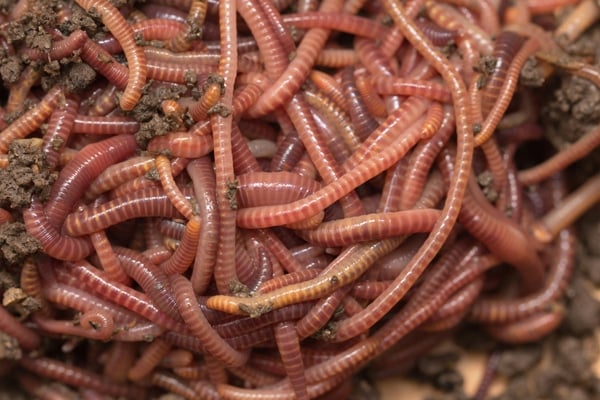Red Wiggler Express: Providing Anglers with High-Quality Worms
Red Wigglers 101: Everything You Need to Know for Thriving Gardens
Red wigglers, or Eisenia fetida, play a critical duty in lasting horticulture methods, offering as effective decomposers that convert organic waste into beneficial vermicompost. Understanding their environment, nutritional choices, and the myriad advantages they provide can change your gardening approach.
Comprehending Red Wigglers

Red wigglers thrive in atmospheres rich in natural product and moisture. Red Wiggler Express. They possess a distinct digestion system that permits them to refine food scraps rapidly, eliminating spreadings that are loaded with essential nutrients such as nitrogen, phosphorus, and potassium. These castings improve dirt framework, improve water retention, and foster beneficial microbial activity, every one of which add to durable plant health and wellness
Furthermore, red wigglers can make it through in varied problems, making them versatile to various gardening practices, including indoor and outdoor composting systems. Their capacity to consume large amounts of natural waste day-to-day placements them as beneficial allies for both home garden enthusiasts and commercial growers. By incorporating red wigglers right into horticulture efforts, one can significantly enhance dirt fertility and assistance sustainable horticulture methods.
Perfect Environment for Red Wigglers
Developing an ideal setting for red wigglers is vital for maximizing their composting capabilities and overall health and wellness. Red wigglers grow in damp, dark, and well-aerated habitats, which closely resemble their native environments in ground cover and rotting raw material. A suitable environment needs to provide a temperature range between 55 ° F and 77 ° F(13 ° C to 25 ° C), as extreme temperatures can worry or damage the worms.
The bed linen material, such as shredded paper, cardboard, or coconut coir, should be maintained moist yet not extremely damp, as excessive moisture can lead to anaerobic conditions detrimental to worm wellness. Additionally, a pH degree in between 6.0 and 7.5 is ideal, making sure a well balanced setting.
Correct aeration is similarly important; it enables oxygen circulation and protects against the build-up of damaging gases. A container or bin created for vermicomposting need to have drainage holes to remove excess dampness and advertise air movement. Regular tracking of these problems is essential for keeping a thriving red wiggler populace, ultimately enhancing their efficiency in breaking down natural waste and improving garden soil.
Dietary Requirements and Preferences

Red wigglers display particular choices; they are especially warm of softer, decaying products over harder or more coarse substances. It is vital to stay clear of feeding them citrus peels, onion, and garlic in big amounts, as these can be hazardous. Additionally, meat, dairy products, and oily foods must be left out, as they can attract bugs and develop undesirable smells.
(Red Wiggler Express)To keep optimum health, a well balanced mix of green and brownish materials is recommended. Green materials, such as veggie scraps, give nitrogen, while brownish products, like cardboard and dried out leaves, supply carbon. Monitoring the moisture content and making sure a constant food supply will even more boost their development and composting capabilities. By catering to their dietary requirements, garden enthusiasts can foster a flourishing populace of red wigglers in their compost systems.
Benefits of Using Red Wigglers
The impressive advantages of utilizing red wigglers in gardening expand far past their duty in composting. These functional microorganisms add dramatically to dirt health and wellness, boosting nutrient accessibility and advertising microbial activity. By freshening the soil as they delve, red wigglers enhance water drainage and origin penetration, producing an optimum atmosphere for plant growth.
Furthermore, red wigglers are reliable recyclers of natural waste, transforming it into nutrient-rich spreadings that function as an excellent natural plant food. These spreadings have useful microorganisms and important nutrients, such as nitrogen, phosphorus, and potassium, which are crucial for plant development. The sluggish launch of nutrients from worm spreadings ensures a steady supply, minimizing the danger of nutrient leaching and advertising sustainable gardening methods.
Additionally, the visibility of red wigglers can help suppress soil-borne plant diseases. Their digestion processes generate substances that inhibit unsafe microorganisms, therefore improving plant health and wellness. Finally, using red wigglers promotes a much more lasting gardening approach by lowering dependence on chemical fertilizers and promoting a closed-loop system, where waste is changed into important resources. Generally, including red wigglers right into horticulture practices provides a wide variety of eco-friendly and agricultural benefits.
(Granite Falls NC Worms For Sale)
Composting With Red Wigglers

To start an go now effective vermicomposting system, pick a suitable container with appropriate air flow and drain. The perfect atmosphere for red wigglers consists of a wet, dark setup with temperatures in between 55 ° F and 77 ° F. Begin by layering shredded paper, cardboard, and food scraps, guaranteeing a balanced mix of carbon and nitrogen-rich products.
Red wigglers grow on vegetable peels, fruit scraps, coffee grounds, and eggshells, while avoiding meat, dairy, and oily foods that can draw in bugs. Frequently monitor wetness degrees; the bed linen should be damp but not soggy. Harvest worm spreadings every couple of months by separating the worms from the garden compost, which can then be used straight in yards or saved for later use.
Implementing vermicomposting not only lowers garbage dump waste but additionally enriches garden soil, promoting healthy plant growth and lasting gardening practices. Embrace this environmentally friendly approach to improve your horticulture undertakings.
Verdict
In summary, red wigglers are necessary organisms for improving yard productivity through effective composting. Their certain environment demands, dietary choices, and significant benefits add to lasting horticulture practices. By utilizing red wigglers, gardeners can significantly boost soil high quality and nutrient schedule, fostering much healthier plant growth. Accepting the technique of vermicomposting not just supports waste reduction but also advertises an eco-friendly equilibrium within yard ecological communities, ultimately leading to flourishing and resistant gardens.